Sony Q&A: What’s it take to change the game?
posted Wednesday, December 4, 2013 at 8:19 PM EDT

A little over three years ago, there was a very visible shift in Sony's camera lineup, starting with the extremely well-received NEX-5. It turns out that one individual has been the driving force behind most of Sony's recent string of successes. And what a string they are -- the RX1, RX1R, RX100 and RX100 II compacts, the smartphone-extending QX series (which are wildly successful, just not so much among the dedicated photo community), the full-frame A7 and A7R mirrorless cameras, and the RX10 bridge camera.
The man behind all of these products is Kimio Maki, and he's the senior general manager of the Digital Imaging Business Group at Sony Corp. Imaging Resource publisher Dave Etchells had a chance to sit down with him at the recent PDN PhotoPlus Expo, and it proved to be a very interesting interview indeed. Also taking part in the discussion was the ever-insightful Mark Weir, senior manager of technology and marketing at Sony Electronics Inc.
Together, Maki-san and Mark Weir gave us a great insight for how many of these products came to market, Sony's plan for its new full-frame FE lens line, the amazingly fine adjustments that are made to every RX1 or RX1R coming off the production line, how to get the best night videos out of a Sony RX10, and a whole lot more besides.
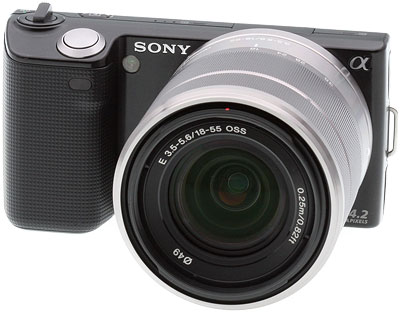
Dave Etchells/Imaging Resource: I understand that you were a primary force behind a lot of the latest digital imaging developments, going back to the original NEX cameras. The NEX-5 was a real eye-opener for the industry. Can you share any of your thinking that led to that development? It really kicked off a whole series of innovations for Sony: What led to the NEX-5?
Kimio Maki/Sony Corp.: In general, the most important thing is, what is Sony's spirit? Sony's spirit is creating something new, which never existed before. And also, downsizing technology as well -- make it smaller, more compact, even the camera system itself. Then, we investigated customers' demands, such as digital SLR users. Everyone has got some stress to carry those camera systems, because they're heavy, but actually, the demand is to get a better picture than the compact digital still cameras. Also, at the moment, smartphones started to increase their penetration. Some users started to say, "That picture quality is good enough for my pictures." In that case, I don't need to take a digital still camera instead of my smartphone. But actually, I want to take a better picture -- then the customers started to have some interest in the digital SLR type of product.
Thinking about something new, though, [we asked] do we really need a mirror box? Of course, we have some excuse, but we can fulfill the customer's demand to make it small, light, and easy to carry. That is one of the conclusions which led to the NEX-5 type of product -- that's the reason why we started to develop that type of small product. In line with those philosophies, currently this problem is existing, because full-frame cameras are quite heavy. It's very tough to use for most consumers; therefore, entry-level users don't like that kind of heavy, big camera system, because they're heavy and expensive -- and also the lens itself is too big.
That's when we started to realize the upgrades, and relieve that stress -- we considered what was the best way to reduce the size, and also to make something new. And then it happened with the NEX-5 and Alpha A7 as well. That point is the philosophy of the Sony spirit, is to create something new which never existed before. We will keep on working to create that kind of product in the future, with that spirit.
DE: So, with the NEX-5, you began development on that a couple of years before the product came out, and at that point in time, you said you saw that cell phones were going to be taking out the lower-end market, but also that the higher quality cameras were too big for people. So you said, "Let's find something for the people that want something more than a cell phone can provide, but that's not this gigantic piece of equipment as well." I see.
KM: Yeah.

DE: We really like the RX1 and RX1R a lot. I'm curious how those have been doing in the market? I'm not looking for specific numbers, but has it met your expectations in terms of volume, not met them, or exceeded them?
KM: First, I have to explain about the concept of the product itself. The concept of the RX-series is spreading to the street segment right now, the street customers' demand. Number one is: the best picture quality in their pocket, in the bag. Every time you can carry the best picture quality in the bag and the pocket, that is the RX100 series. Current digital still cameras, the quality itself is good enough right now.
Then, we consider, what is the best way? Because we're a manufacturer developing the imaging sensors, basically the number one imaging sensor manufacturer. So we decided to create a new type of imaging sensor, which is the 1 inch style -- That is the best way to realize the best picture quality in your pocket. That is one concept. Number two is the RX1. The RX1 is my dream, basically. [laughs]
DE: Really?
KM: That's my dream. As I said, the full-frame is too big to carry on the weekend, to take a picture for my daughter. So, I wanted to create the best camera to carry on the weekend for snapshots. APS-C size sensor isn't good enough quality. But no one could see putting that big sensor -- 35mm -- in such a small body, even our engineers. Back then, around the office, everybody said, "Are you crazy?" I said, "Yeah." [laughs] "I think we can find some solution to fit it in -- let's consider it together." Then our team created that kind of product.
And again, now we've opened the door to a product like the RX10. A big lens system such as f/2.8 lenses is really too big to carry. With the [f/2.8] 24-70 and the 70-200, two lenses are necessary to carry, to take your pictures. But that's quite heavy for the older guys, and also for family fathers -- dads and seniors -- it's too heavy. That is, for me as well. Then, again, I asked my engineers, "Can we put them in together, in one lens?" Then they say...
DE: "You're crazy"?
KM: Right. [laughs] It took some time to develop this kind of lens. Now, for events such as sports events and also trips, a trip to somewhere around the world -- in those cases, the RX10 is our best camera to carry on that trip. The point of the concept of this RX-series is to have "exchangeable cameras," case by case. When you go to the office, put the RX100 in the bag. When you go to somewhere to walk around, take the RX1 with you. If you travel to Japan, or somewhere around the United States, carry the RX10 as your partner. That is the concept of the RX-series -- the "exchangeable" camera series.
DE: A camera for every season, then. [grins]
KM: Sure, sure. It depends on your occasions. [Ed: We're sure Sony loves the idea of each of us owning three RX-series cameras!]
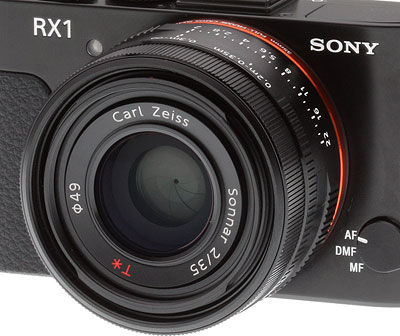
DE: In the RX1 -- that's a very unique lens that you developed then. I either read or heard in another interview, perhaps with someone in manufacturing, that you adjust the lens on every camera as part of manufacturing, to make sure the alignment is perfect.
KM: Lens and imager.
DE: And the number I heard was that you can adjust to an accuracy of one micron?
KM: Less than one micron.
DE: And that test is actually done on every camera that comes through?
KM: Exactly, yes. The professional cameraman said, when they used the RX1, "Now I recognize how it's not precise this lens, this flange-back system itself." The flange-back has to adjust for every lens you attach to it. [gesturing above the table surface, to indicate how each lens may be slightly out of alignment] There are always some differences existing in the manufacturing, [between parts]. If we look at lens 1, lens 100, lens 1,000, they're not perfect, you need to make some allowances. You have an adjustment, but sometimes with some combination of camera and lens, when you make very large pictures, you can see that it's not precise. Now, with the RX1, we can adjust every single lens together with every single imaging sensor, to less than 1-micrometer levels. Therefore, the picture quality and preciseness is the best in the world, I think.
DE: That's very interesting.
KM: No one could recognize it, because professional photographers don't use a fixed camera lens system. But every time they change their lens, they trust that part [points to the lens mount on the camera] that should be the reference for every lens system. But actually, our engineers knew, that is not the reference -- there are some tolerances there, so we fixed it [in the RX1 and RX1R]. We fixed it, and we minimized it, to less than 1 micrometer. Therefore, the picture quality itself is really, really [recognized] by everyone.
DE: With a really premium product like that, with a $2,800 price point, you can afford to do that individual adjustment on each camera. But a lot of people who would like to own RX1s don't have the money. Is there a possibility that you can come up with a less expensive model that you can still maintain those types of tolerances on?
KM: In the future, it will happen. Right now, it is very tough to realize that kind of pricing point. Looking at the lens, the specification of the lens is really good, even MTF data is very good. We've probably never seen [MTF] data like this in an interchangeable lens. And also the 35mm full-frame, combine together, the pricing is reasonable right now, but in the future, if we can make it more easily, that may happen.
DE: You're at the point where it takes so much effort and the lens is very expensive itself.
KM: Yeah. Actually, the most difficult thing is not adjustment, it's dust. When you use f/11 or more than f/16 and f/20, f/22, you can see even very, very small dust that's in the lens system. Because the size is 0.004 micrometers.
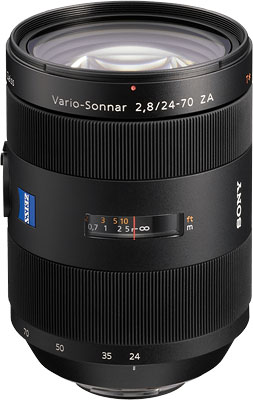
DE: You can see dust in the lens that's 0.004 microns?
KM: Exactly. I can't see anything with my eyes, not at all, but some ladies, the younger generation, can recognize the dust itself in here.
When I went to the line for the manufacturing of the lens, they said "Maki-san, I have some questions. Can you recognize that there's some dust on the lens here?" I couldn't recognize it, [even examples they thought were very obvious.]
DE: So it's 4 nano-meters, wow.
MW: Due to the nature of a shot captured with a very narrow aperture, on a very large image sensor, very high magnification.
DE: Let's switch and talk about about the lens line-up. In the U.S. -- I'm thinking specifically the NEX line -- the early mirrorless adoptions were with enthusiast users, but worldwide, it was more consumers, so the lenses were really oriented towards a consumer audience, rather than enthusiasts. Enthusiasts have really been wanting better lenses on the NEX system for some time now. It looks like they're starting to get what they asked for with the 25-70mm that was announced recently, the Zeiss, the new FE-mount lenses for the A7, and also Sigma and other third-party manufacturers are looking to close that gap as well. Can we expect to see more focus from Sony on the higher-end lenses, high quality primes, and higher quality constant-aperture zooms?
KM: Probably we have to show this camera lens line-up, and also our plans. We're going to introduce five lenses as the first stage in this year -- we can send it to you, it's public information. Also, as you said, we're going to introduce 70-200mm f/4 lens in this fiscal year. Within 2014, we're going to have ten types of lenses for this mount, for the FE mount.

Mark Weir/Sony Electronics Inc.: So, five additional.
KM: Yes, five additional, and also by the end of 2015, five more.
DE: And all those lenses can be used on the NEX, they're just a little bit bigger.
KM: Exactly, sure. Sometimes we have macro lens, sometimes we have some longer zoom, based on f/2.8 type of product. So we're planning to introduce five more lenses within this period.
DE: It looked like your initial zooms on the roadmap, the 24-70mm, and 70-200mm, those were all f/4, as opposed to f/2.8. What made the decision to just go with f/4?
KM: It comes from looking at the current market situation. f/2.8 isn't very reasonable, but f/4 is reasonable for every consumer in terms of pricing point, and also the size.
MW: And also optical image stabilization -- there aren't many f/2.8 optically image stabilized full-frame lenses in the world.
KM: Right.
DE: What about the Canon 70-200mm f/2.8?
MW: No, I mean in standard focal lengths, in something that also has wide angle. In the world of 24-70mm f/2.8s, there's only the Sigma that has optical image stabilization. Nikon and Canon don't have stabilization in that focal length range.
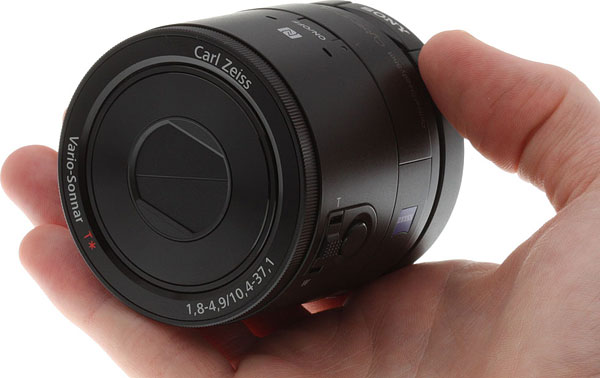
DE: Ah, I was thinking of the 70-200mm range, with the Canon and Nikon 70-200s.
I'm going to switch a little bit to a brand-new line, the QX-series. I have to admit, I'm a little puzzled by them and how they fit into the market. Taking the QX100 in particular, what's the value proposition for buying that versus an RX100 II? One thing that struck me is that, while the total volume is lower for the QX100, the RX100 is a little rectangle that fits into my pocket much more easily. Where do you see the market being?
KM: I am getting this kind of question from other journalists across the world, it's very interesting. Don't get me wrong, our generation is getting older and older, and we love this type of camera system itself. [pointing to an RX100 II on the table] We're used to using cameras like this one. When I investigated the data from the younger generations, and asked "Why don't you use cameras, this kind of camera -- the RX100, the RX100 II type of product? It's a great product, you can take a picture and get much better picture quality than a smartphone." Then they say, the camera itself is good, but it's not trendy because we want to get the image into the smartphone. Of course, we can transfer the image from the camera to the smartphone through the WiFi, but it's [a nuisance], we have to take several steps to transfer the image from the camera to the smartphone. No, no, that takes too much time for me. Everyone wants to get the image straight into their smartphone.
Number two, the interesting data was, I started to take a picture through the smartphone; before, when we were young, we had a great camera in our house, just one camera in our house. Dad bought that one, and we shared the camera together with the others in the family. Now, everybody is getting the experience of photography through the smartphone. Their literacy of pictures and photos is great. Everyone started saying, "It's my hobby -- taking pictures, it's my hobby, I love it." When we asked "Why do you like it, why is it a hobby for you?", they say "Because everybody gives me a ‘like', when you take a picture and show them, and everybody gives me a ‘like'." It's great, very satisfying for me -- everyone started saying, "it's great!" I'm very happy to get these kinds of "likes" through the Internet. Then their demand is to get a better picture, to get more "likes" for their pictures.
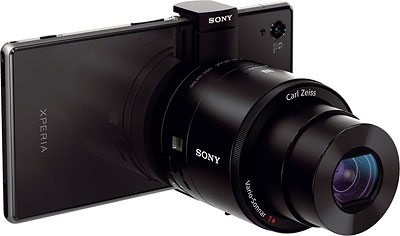
DE: That's really interesting, so it's like the social sharing is driving people's photo hobbies.
KM: That's right. So they say, I don't like using this one [again, pointing to the RX100 II on the table], I want to put the image straight into my smartphone. "I want to get more ‘likes' from everyone," that's their motivation. And so the QX-series was born, based on that data.
MW: So we don't see the customers look at a RX100 II and QX100 and say, "why would I buy this, instead of that?" -- it doesn't make any sense. Instead, we have a whole... I wouldn't call it a generation, but we certainly have a cohort of customers who have grown up using a smartphone for a camera. They're not going to start using cameras -- no one is going to convince them to stop using a smartphone and start using a camera. However, QX can allow them to use their use flow of using a phone, but can allow them to take pictures that they could never take before.
DE: It's like a smartphone enhancer.
KM, MW: Right.
DE: They don't stop and think, "Oh, I need a camera now," but rather "Oh, this thing will make my smartphone take really great pictures."
KM: Right. A QX user doesn't have any interest in buying a camera.
DE: Yeah, that's very interesting. That maybe explains the way the QX100 is configured in terms of its user interface. I had kind of a disconnect when I went to use it, because I was thinking "Ah, here's an RX100 II that connects to my smartphone," but when I went to the control panel on the phone, it was missing all sorts of manual controls.
KM: Sure, that's right.
DE: I see that's where that came from, then -- that non-camera user. But for more advanced users, could there be a firmware upgrade that could give more functionality?
KM: The smartphone has a lot of applications that can be downloaded from the Internet -- but then that new application doesn't work with the QX series. Exactly the same question was given by my boss! [laughs]
When I showed that concept to my boss, he said, "Why do we need to buy that kind of product? The RX100 II is much better than that one, because an LCD screen is on the back. That [QX concept] doesn't have one, why do I need to use that one?" No concept at all. I said "Excuse me, you're not the target user." [Much laughter]
DE: Yes, he doesn't have a phone workflow, he has a camera workflow.
KM: You have to understand their lifestyle, in the younger generations. When we showed the product to the younger generation, young people who were working with us, they said, "That's great, definitely I'll buy that product, rather than the RX100. Sure, the RX100 is a great product, but it's a little bit different feeling, but that product has a great feeling for me. Every time I go out, I'll put that camera in my bag, definitely."
MW: When we showed a QX to photo specialty retailers, the buyers often asked us: "Why would I buy this camera?" My answer to them was, "I don't think you ever will, because we didn't build it for you." [laughter] And now, when we go into photo specialty retailers, some of which will remain unnamed, the only thing they ask us is, "When are you going to ship us more QX100s?"
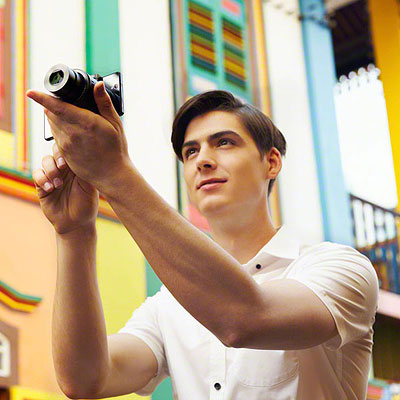
DE: Really! So there's been a very significant uptake by the market?
KM: We're capturing me-generation customers as well, so it's expanding our opportunities.
MW: To a degree that no one anticipated.
DE: So it's way beyond what your projections were?
MW: When we walk into a high-end photo specialty retailer right now, the very first question -- you can't even get the door closed -- and the first question will be, "When are you shipping me more QX100s?"
KM: That's right. The target user is the customers who have never gotten into the camera industry before.
MW: They were very surprised.
KM: And also the smartphone "native", the interface itself is smartphone interface -- they have never used a camera interface before, or yet. They'll take a picture through the smartphone interface, because the zoom -- zoom is like this behavior -- zoom, touch. [demonstrating on a phone/QX combo that was on the table] That is their behavior, their language.
DE: That's how they interact with a picture-taking device.
KM: That's right, and they don't want to change their actions. The camera should be all touch.
DE: In terms of making cameras simple, I'm always in favor of having a simple interface, but then hidden over here for the people that really want to get into it, you've got all the technical details. Do you think there might be a firmware upgrade that would give more capability to the QX100, give it more of the capabilities that the RX100 has?
KM: Yeah… a little bit, but I haven't decided yet. We can do that, but we need to see the customer who we are targeting.
MW: In other words, there's a lot of chatter about, "Why don't you add this? Why don't you add that?" Is that chatter coming from the customers who are using the product, or is that chatter coming from...
DE: Photo geeks like me? [laughter]
MW: People saying, "Gee, I don't understand why Sony doesn't let it shoot RAW," for instance. Is that the customer's voice, or is that the…
KM: I had a very interesting conversation with my boss, he started to promote the products by himself. He said, "We had better put the LCD screen on the back -- we need a flash, we need an accessory shoe." Excuse me -- it'd become the RX100! We have that one! [laughs]
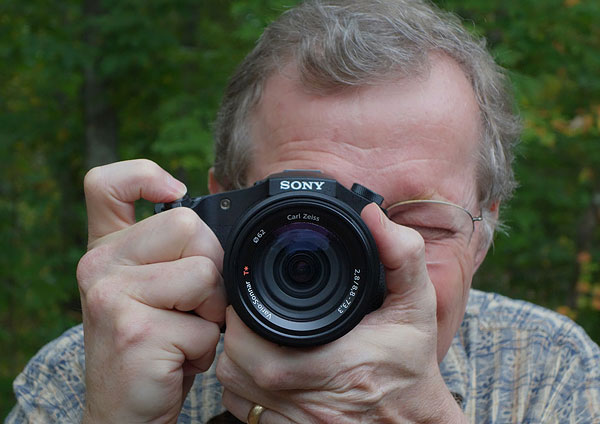
DE: I want to move on to the RX10, that's a very interesting camera. I'm going to take a little bit different direction with that. When I looked at it, I saw that for video, it has the 60p frame rate, it has external jacks for microphone and headphones, and especially it does all-pixel sub-sampling, which seems very significant. I'm calling it "the ultimate video machine," because it really looks like it is -- it's got that great lens, and all the video capabilities. Did you have any particular users or use cases in mind, specifically around video, when you designed it? And do you think it'll find its way into professional applications?
KM: Journalists -- journalists are the target user. It's very, very easy to take a picture, and quality is great. Every journalist in the world who saw the RX10 loved it -- "This is my camera -- this is my camera to take outside to get some interviews."
MW: But not necessarily a camera journalist, but rather a news journalist.
DE: Ah -- with the news journalists, you don't have the camera crew anymore -- very interesting.
KM: This quality itself is more than professional. That picture quality, video picture quality is much better than professional camera systems, even the Super 35mm, the picture quality is better. Much, much better.
DE: When you say better, meaning cleaner signal, or -- ?
KM: Cleaner, sharper, less noise -- everything. [Maki san showed me some comparison videos against the Canon 5D Mark III, which Sony also showed at the NDA event in NYC a few weeks earlier]
MW: Especially the shadow detail.
DE: Yeah, yeah -- huge difference.
MW: [referring to the video from the full-frame 5D Mark III] Here's an image sensor that's many times larger than the 1-inch sensor, but because of the advantage of no line-skipping...
DE: Yeah, there's actually better detail in a lot of places.
[Ed: The reference to "line-skipping" refers to the way essentially all DSLRs subsample their images for video. Rather than doing a proper downsampling, they just skip over rows of pixels when reading out the sensor. This lets the sensor and processor keep up with the video frame rate, but at the expense of moiré and other artifacts. You also lose a lot of the potential benefit of the large sensor area, since you're discarding data from many of the pixels. In contrast, the RX10 reads out every pixel for every video frame, and then averages them together as needed, to end up with the final video resolution. This not only reduces artifacts, but reduces image noise as well.]
KM: When we started to develop this sensor, we knew the potential of the sensors. The same team who developed the Super 35mm sensor which goes in our professional camera systems, and the 1-inch imaging sensor which goes in the consumer electronics -- every engineer said, "Maki-san, it could be trouble! The picture quality of that [RX10] sensor is better than this one [the Super 35mm]." I said "That is my target! [laughs] Why don't you know that?"
And also, for that journalist or a student who is learning photography and videography, the 5D Mark III is very expensive right now, so you can now get better video image quality at half the price.
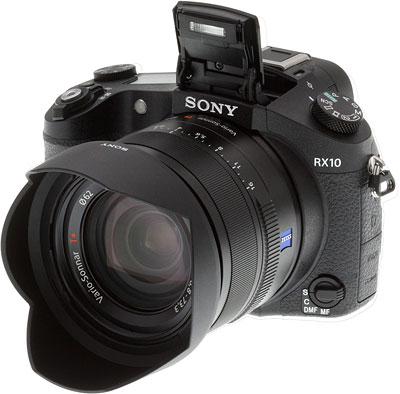
DE: Yeah, and with a 28-200mm f/2.8 lens.
KM: Yeah, with the lens included.
MW: And with the neutral density filter built in, so you can use that aperture.
DE: So the video image quality is better than the 5D Mark III. The data rate, though, maxes out at 28 Mbps. I know Panasonic has pushed into 50 Mbps.
MW: Well, that's an issue of the internal codec. If you wanted to record to an external recorder, you can overcome that.
DE: So this will actually stream uncompressed video?
MW: Yes. It has HDMI output so you can record to an external recorder; you can get ProRes out of it, if you want.
DE: ProRes? I don't know that term.
MW: ProRes is a codec from Apple. [Ed: The company describes it as "visually lossless", but it is technically still a lossy format.]
DE: That answers that, then. So for truly professional applications, you can couple the RX10 an external recorder.
MW: Yeah, an AJA, Codex Digital, or Atomos Ninja.
KM: Also, you can use an external gun mic. We have an XLR box, and a Canon connector is available.
DE: This is my last set of questions -- it's about the RX10, and I really wanted to get to it. With all-pixel sampling, it occurs to me that it can help overcome the smaller pixel limitation. A 5D Mark III has big pixels, but it skips lines. So if you take a bunch of smaller pixels and process them, does that sub-sampling or re-sampling help with low light and noise levels as well?
KM: Yes, of course, yes.
MW: For video.
DE: For video, yes, that's what my question was about. My impression was -- it was only kind of hinted at in the presentation -- but my impression was that there's a whole new, separate LSI front end in the BIONZ X processor, just for that sub-sampling?
KM: Yeah, and not only that, but the image sensor design is quite important, to be able to take every pixel for movies.
DE: So the image sensor has a very different architecture...
KM: Yes, it's faster, faster.
DE: I thought it was the same sensor as the RX100 II, though?
MW: It's the same image sensor as the 100 Mark II. What the LSI is doing is it's peeling the data from the sensor and putting it in the order it needs to be, and it's also managing much of the auto-focus operations as well. In the BIONZ X is where this kind of work is being done.

DE: Oh, so it's actually part of BIONZ X.
MW: Yes. The reason why this camera can shoot this way in a way that the RX100M2 cannot, is the difference in BIONZ X and the previous BIONZ.
DE: So there's a sub-system in the BIONZ X that's doing the buffering and the averaging.
KM: Sure.
DE: Did adding that capability have any negative impact on power consumption?
KM: As for power consumption, it's very much similar -- well, less than previous.
DE: Less than previous? So you added all this processing, but you went to a smaller -- you shrunk the semiconductor process.
MW: Right.
DE: Another question I had, about 60p and clocking the entire chip like that, is what happens to the temperature?
KM: It's within the specifications. We have some limits when we use chips. It's less than that limit, the margin of safety is about 25-30 degrees.
DE: So say I'm in a low light situation and really concerned about noise -- if I shot at 30p instead of 60p, would that give me a cleaner signal? (Because it wouldn't heat the sensor as much.)
KM: That's right, yes. That's a different aspect than with the pixel sampling, depending on the chip temperature and temperature of the image sensor.
DE: On the RX10, it looks like you've made huge strides in JPEG processing. You have this diffraction compensation -- does that adjust only based on the aperture, or is it also a function of focal length? Does it change its processing at different focal lengths?
KM: No.
DE: No, it's strictly aperture -- OK. We saw something interesting in the RX1R: its JPEGs were much sharper than the RX1's, but the RAW files were actually very similar. I'm wondering if some of the processing that's now in the RX10, was also in the RX1R?
KM: No, I don't think so.
DE: OK. Well, I see that we're more than out of time, thanks very much for spending the time with me and answering all my questions. I think our readers will find this very interesting!
KM: Thank you.